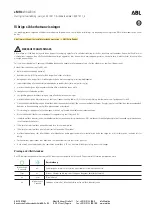
Lada Niva Manual - Maintenance
Page 27
Storage Battery
Every 2,500 Km or every four months check the electrolyte
level in the battery cells (Fig. 66). The level should be between
the MIN and MAX marks on the semi-trans- parent battery
case; otherwise the level should reach the lower edge of the filler
holes. Top up the cells only with distilled water.
Never add non-distilled water or distilled water kept in a metal
vessel. Electrolyte should be added into the storage battery only
in case when it is known for sure that lowering of the electrolyte
level has occurred due to splashing out. In this case, the added
electrolyte should be of the same specific gravity as that
contained in the battery.
Operation of the battery with a low electrolyte level is impermissible since it results in
sulphation of the exposed portions of the plates and reduction of the battery capacity.
Check the electrolyte level more frequently in hot weather. The battery should always be
clean and dry, particularly its upper surface. Remove the traces of electrolyte with clean rags
soaked in a 10 % solution of ammonia water or soda. Regularly check cleanness of the vent
holes in the plugs and condition of the battery container.
Every 10,000 Km and also in case of frequent failures in engine starting, check the state of
charge by measuring the electrolyte specific gravity with a hydrometer.
Check the hydrometer readings against the data given in Table 4. (
Not included yet
) If the
electrolyte temperature is other than 25"C, introduce corrections to the hydrometer readings
(see Table 5).
Every 20,000 Km check the battery for cleanness and for reliable fastening of terminals and
clamps; clean them and coat with aerosol lubricant BTB-l.
If the car is to be inoperative for less than a month, disconnect the negative (ground) wire
from the battery. Do not leave the wire clamp on the battery surface. When the car is to be out
of service for a longer period remove the battery from the car, fully charge it and keep it,
whenever possible, in a dry cool room at a temperature not above O"C. The minimum storage
temperature should not be below minus 50 "C.
Never store the discharged battery since this will lead to sulphation of plates, and finally, to
a complete failure of the battery. Therefore, be sure to check the battery specific gravity every
month, charging it whenever necessary.
Alternator
Every 10.000 Km carefully dress the alternator slip rings with glass cloth, check the brushes
for wear and seating and replace them if necessary. The brushes should move easily in the
holders and should have no chippings. When the car is driven constantly on dusty and dirty
roads perform this operation more frequently.
Starter
Every 40.000 Km carefully dress the commutator, check the brushes for wear and seating
and, whenever necessary, replace them with new ones, having them bedded properly to the
commutator.
Fig 66. Holes for checking
electrolyte level in storage battery
cells







































